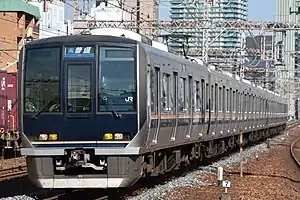| 321 series | |
|---|---|
 321 series set D11 in February 2021 | |
| In service | 2005–present |
| Manufacturer | Kinki Sharyo |
| Built at | Higashiōsaka |
| Replaced | 201 series, 205 series, 207 series (set Z16) |
| Constructed | 2005–2007 |
| Entered service | December 2005 |
| Number built | 273 vehicles (39 sets) |
| Formation | 7 cars per trainset |
| Fleet numbers | D1–D39 |
| Operators | JR-West |
| Depots | Aboshi |
| Lines served | Tōkaidō Main Line, Sanyō Main Line, Kosei Line, Fukuchiyama Line, JR Tōzai Line, Katamachi Line, Yamatoji Line |
| Specifications | |
| Car body construction | Stainless steel |
| Train length | 136.600 m (448 ft 2.0 in) |
| Car length | 19.55 m (64 ft 2 in) (end cars)[1] 19.5 m (64 ft 0 in) (intermediate cars) |
| Width | 2,950 mm (9 ft 8 in)[1] |
| Height | 3,630 mm (11 ft 11 in)[1] |
| Doors | 4 pairs per side |
| Maximum speed | 120 km/h (75 mph) |
| Weight | 232.8 t (513,236 lb)[1] |
| Traction system | Variable frequency (2-level IGBT)[1] |
| Power output | 270 kW (362 hp) |
| Acceleration | 2.5 km/(h⋅s) (1.55 mph/s) |
| Deceleration | 4.2 km/(h⋅s) (2.61 mph/s) (emergency) |
| Electric system(s) | 1,500 V DC overhead[1] |
| Current collector(s) | WPS27D scissors-type pantograph |
| Bogies | WDT63 (powered), WTR246/WTR246A (trailer) |
| Braking system(s) | Regenerative brake, electronically controlled pneumatic brakes, snow-resistant brake |
| Safety system(s) | ATS-SW, ATS-P |
| Track gauge | 1,067 mm (3 ft 6 in) |
The 321 series (321系, 321-kei) is a DC electric multiple unit (EMU) commuter train type operated by West Japan Railway Company (JR-West) in the Kansai Region of Japan.
Overview
The 321 series was developed from the earlier 207 series to replace the ageing 201 series and 205 series trains on the Tōkaidō Main Line.[2] One 321 series set also replaced the 207 series (set Z16) withdrawn due to collision damage sustained in the Amagasaki derailment of 25 April 2005.
Operations
The 321 series share the same assignments as their 207 series counterparts.[3][4] All 39 sets are allocated to Aboshi depot.
- Tōkaidō Main Line and Sanyō Main Line: Yasu – Kakogawa
- Fukuchiyama Line: Osaka – Sasayamaguchi
- JR Tōzai Line and Katamachi Line: Amagasaki – Kizu
- Osaka Higashi Line and Kansai Main Line (Yamatoji Line) (until 17 March 2023)
Formation
| Car No. | 1 | 2 | 3 | 4 | 5 | 6 | 7 |
|---|---|---|---|---|---|---|---|
| Designation | M'c | M | T | M' | M | M' | Mc |
| Numbering | KuMoHa 320 | MoHa 321 | SaHa 321 | MoHa 320 | MoHa 321 | MoHa 320 | KuMoHa 321 |
| Capacity | 142 | 156 | 142 | ||||
| Weight | 35.1 t | 34.1 t | 27.3 t | 33.3 t | 34.1 t | 33.3 t | 35.6 t |
KuMoHa 321 and MoHa 321 cars each have two scissors-type pantographs.
Interior
 Original interior style in June 2010
Original interior style in June 2010 Interior following changes to seat covers and hanging straps, December 2021
Interior following changes to seat covers and hanging straps, December 2021 Priority seating and free space, December 2021
Priority seating and free space, December 2021 LCD passenger information display
LCD passenger information display
References
- JR全車両ハンドブック2006 (JR Rolling Stock Handbook 2006). Japan: Neko Publishing. 2006.
- JR電車編成表 '07冬号 (JR EMU Formations – Winter 2007). Japan: JRR. December 2006. ISBN 978-4-88283-046-7.
- 1 2 3 4 5 6 "Electric Equipment of Series 321 Train" (PDF). toyodenki.co.jp (in Japanese). October 2005. Archived (PDF) from the original on 24 December 2017. Retrieved 8 December 2021.
- ↑ "321系通勤形直流電車の新製投入" [Introducing a new 321 series commuter DC train]. westjr.co.jp (in Japanese). 8 July 2005. Archived from the original on 30 August 2005. Retrieved 8 December 2021.
- ↑ JR電車編成表 [JR train organization table] (in Japanese). Japan: 交通新聞社. 16 November 2016. p. 178. ISBN 9784330737164.
- ↑ 柴田, 東吾 (January 2015). "JR西日本207系の歩みと現状" [Railway Fan]. 鉄道ジャーナル社 (in Japanese). 579: 93.
External links
Wikimedia Commons has media related to JR West 321.
- Kinki Sharyo information Archived 17 March 2009 at the Wayback Machine (in Japanese)
This article is issued from Wikipedia. The text is licensed under Creative Commons - Attribution - Sharealike. Additional terms may apply for the media files.